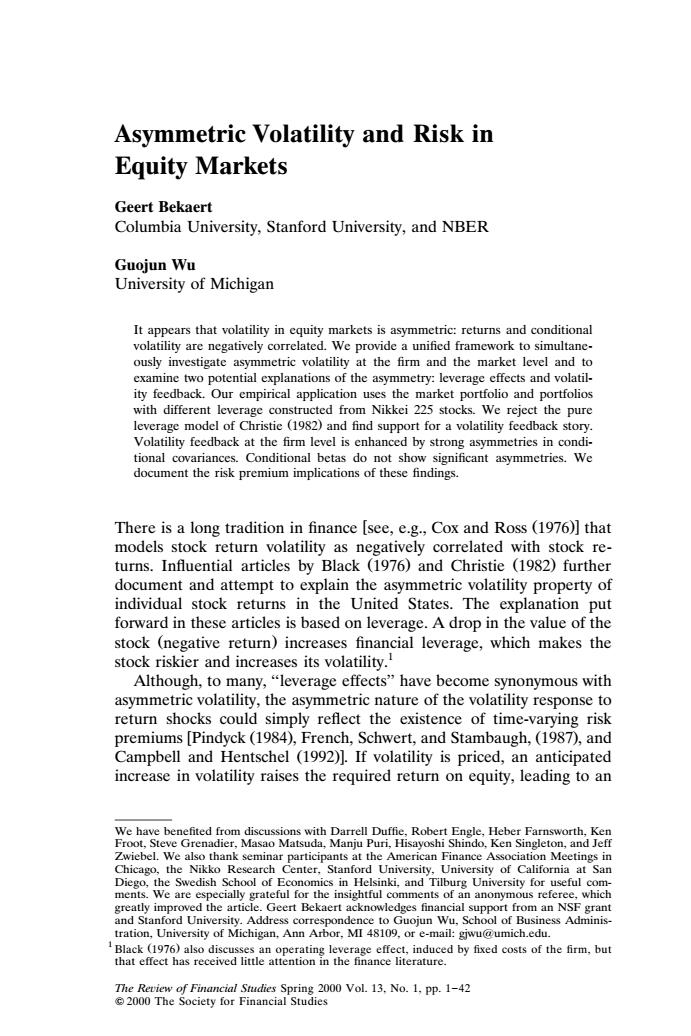正在加载图片...

Asymmetric Volatility and Risk in Equity Markets Geert Bekaert Columbia University,Stanford University,and NBER Guojun Wu University of Michigan It appears that volatility in equity markets is asymmetric:returns and conditional volatility are negatively correlated.We provide a unified framework to simultane- ously investigate asymmetric volatility at the firm and the market level and to examine two potential explanations of the asymmetry:leverage effects and volatil- ity feedback.Our empirical application uses the market portfolio and portfolios with different leverage constructed from Nikkei 225 stocks.We reject the pure leverage model of Christie (1982)and find support for a volatility feedback story. Volatility feedback at the firm level is enhanced by strong asymmetries in condi- tional covariances.Conditional betas do not show significant asymmetries.We document the risk premium implications of these findings. There is a long tradition in finance [see,e.g.,Cox and Ross (1976)]that models stock return volatility as negatively correlated with stock re- turns.Influential articles by Black (1976)and Christie (1982)further document and attempt to explain the asymmetric volatility property of individual stock returns in the United States.The explanation put forward in these articles is based on leverage.A drop in the value of the stock (negative return)increases financial leverage,which makes the stock riskier and increases its volatility. Although,to many,"leverage effects"have become synonymous with asymmetric volatility,the asymmetric nature of the volatility response to return shocks could simply reflect the existence of time-varying risk premiums [Pindyck(1984),French,Schwert,and Stambaugh,(1987),and Campbell and Hentschel (1992)].If volatility is priced,an anticipated increase in volatility raises the required return on equity,leading to an We have benefited from discussions with Darrell Duffie,Robert Engle,Heber Farnsworth,Ken Froot,Steve Grenadier,Masao Matsuda,Manju Puri,Hisayoshi Shindo,Ken Singleton,and Jeff Zwiebel.We also thank seminar participants at the American Finance Association Meetings in Chicago,the Nikko Research Center,Stanford University,University of California at San Diego,the Swedish School of Economics in Helsinki,and Tilburg University for useful com- ments.We are especially grateful for the insightful comments of an anonymous referee,which greatly improved the article.Geert Bekaert acknowledges financial support from an NSF grant and Stanford University.Address correspondence to Guojun Wu,School of Business Adminis- tration,University of Michigan,Ann Arbor,MI 48109,or e-mail:giwu@umich.edu. Black(1976)also discusses an operating leverage effect,induced by fixed costs of the firm.but that effect has received little attention in the finance literature. The Review of Financial Studies Spring 2000 Vol.13.No.1,pp.1-42 2000 The Society for Financial StudiesAsymmetric Volatility and Risk in Equity Markets Geert Bekaert Columbia University, Stanford University, and NBER Guojun Wu University of Michigan It appears that volatility in equity markets is asymmetric: returns and conditional volatility are negatively correlated. We provide a unified framework to simultaneously investigate asymmetric volatility at the firm and the market level and to examine two potential explanations of the asymmetry: leverage effects and volatility feedback. Our empirical application uses the market portfolio and portfolios with different leverage constructed from Nikkei 225 stocks. We reject the pure leverage model of Christie 1982 and find support for a volatility feedback story. Ž . Volatility feedback at the firm level is enhanced by strong asymmetries in conditional covariances. Conditional betas do not show significant asymmetries. We document the risk premium implications of these findings. There is a long tradition in finance see, e.g., Cox and Ross 1976 that Ž . models stock return volatility as negatively correlated with stock returns. Influential articles by Black 1976 and Christie 1982 further Ž. Ž. document and attempt to explain the asymmetric volatility property of individual stock returns in the United States. The explanation put forward in these articles is based on leverage. A drop in the value of the stock negative return increases financial leverage, which makes the Ž . stock riskier and increases its volatility.1 Although, to many, ‘‘leverage effects’’ have become synonymous with asymmetric volatility, the asymmetric nature of the volatility response to return shocks could simply reflect the existence of time-varying risk premiums Pindyck 1984 , French, Schwert, and Stambaugh, 1987 , and Ž. Ž. Campbell and Hentschel 1992 . If volatility is priced, an anticipated Ž . increase in volatility raises the required return on equity, leading to an We have benefited from discussions with Darrell Duffie, Robert Engle, Heber Farnsworth, Ken Froot, Steve Grenadier, Masao Matsuda, Manju Puri, Hisayoshi Shindo, Ken Singleton, and Jeff Zwiebel. We also thank seminar participants at the American Finance Association Meetings in Chicago, the Nikko Research Center, Stanford University, University of California at San Diego, the Swedish School of Economics in Helsinki, and Tilburg University for useful comments. We are especially grateful for the insightful comments of an anonymous referee, which greatly improved the article. Geert Bekaert acknowledges financial support from an NSF grant and Stanford University. Address correspondence to Guojun Wu, School of Business Administration, University of Michigan, Ann Arbor, MI 48109, or e-mail: gjwu@umich.edu. 1 Black 1976 also discusses an operating leverage effect, induced by fixed costs of the firm, but Ž . that effect has received little attention in the finance literature. The Reiew of Financial Studies Spring 2000 Vol. 13, No. 1, pp. 142 2000 The Society for Financial Studies����